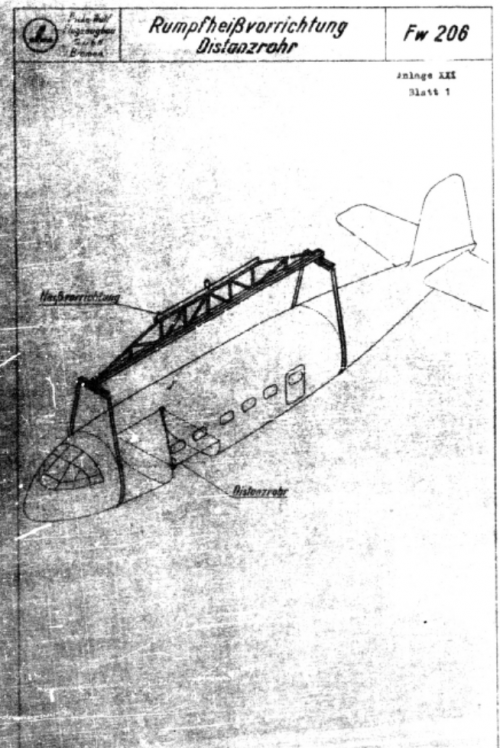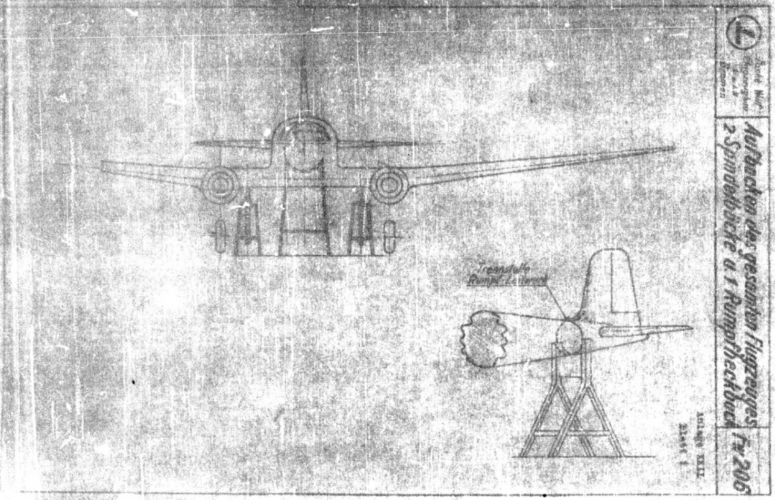Refer attached pics from Luftfahrt international 25 from 1978
You are using an out of date browser. It may not display this or other websites correctly.
You should upgrade or use an alternative browser.
You should upgrade or use an alternative browser.
Focke-Wulf Fw 206
- Thread starter GTX
- Start date
Steve Pace
Aviation History Writer
- Joined
- 6 January 2013
- Messages
- 2,266
- Reaction score
- 225
Germany's version of the DC-3/C-47 series? -SP
Tophe
ACCESS: Top Secret
Does someone know in which year was designed this project?
I understand it started in late 1940.
Regards,
Greg
Regards,
Greg
The Fw 206 projcet was stopped due to the beginning of the WWII. Was planned as a competition for the Junkers Ju 52/3m in commercial airline service for short and middle range. The project was from 1938 and was planned with 2 BMW-Bramo-323.
http://de.wikipedia.org/wiki/Focke-Wulf_Fw_206
The picture i found there:
http://www.flying-things.ch/seite33.htm
http://de.wikipedia.org/wiki/Focke-Wulf_Fw_206
The picture i found there:
http://www.flying-things.ch/seite33.htm
Attachments
- Joined
- 3 June 2006
- Messages
- 3,094
- Reaction score
- 3,949
- Joined
- 6 November 2010
- Messages
- 5,251
- Reaction score
- 5,480
From "Kurt Tank - Konstrukteur und Testpilot bei Focke-Wulf" by Wolfgang Wagner, Bernard & Graefe Verlag, 1991 (my translation):
Data supplied by fightingirish match those in Wagner's book.
Fw 206, a German DC-3
The experiences with the Fw 200 Condor were the basis of a good collaboration between Focke-Wulf and Lufthansa, where the definition of further projects was taken on by the partners and realised by the manufacturer. These designs were proceeded with well into the war.
Lufthansa was looking for a replacement for the Ju 52/3m and considered - spurred by the Americans' favourable experiences with the DC-3 - a well performing, twin engined, short- to medium-range aircraft, able to perform many roles. Five items constituted Lufthansa's demands:
- Expected payload between 2,000 and 2,500kg;
- On failure of one engine, flying qualities were to be maintained, as well as altitude, in order to still reach its destination;
- On failure of one engine, the aircraft should also still be able to go around - with undercarriage extended;
- Payload was to consist of 14 to 18 passengers, with luggage of 1,400 to 1,800kg, freight 500 to 700kg. With fewer passengers, appropriately more freight was to be carried;
- Range should be 1,200km, with additional reserves.
The design that resulted from these demands was a cantilever, all-metal, low-wing aircraft with retractable undercarriage, tailwheel and landing flaps, with a takeoff weight between 10,000 and 13,000kg. The aircraft should carry 15 passengers and 620kg of luggage over 1,200km. Originally, Bramo 323 R-2 engines of 735kW (1,000hp), previously used in the Fw 200 C-1 and C-2 were planned. Later, a projected BMW 800 was to be fitted, which at 882kW (1,200hp) would have offered better performance. In single-engine performance, at a weight of 10,160 kg, the finished design was to have a climbing rate of 1.5m/s up to an altitude of 800m. With downrated engines, a climbing rate of 1m/s up to 2,000m was expected. In February 1941, the Fw 206 mockup was inspected by Lufthansa representatives. Negotiations were in hand about a first order for six aircraft.
Shortly after, the project was passed from the Bremen factory to the French SNCASO in Paris-Chatillon, where Dipl.-Ing. Bansemir [...] was involved with a development of the Fw 200 Condor. There, work on the Fw 206 - including construction of production facilities - was taken on, up to starting serial production. By order of the RLM, preparations were cancelled on October 1st, 1942 and construction was postponed until such time as the war ended.
Data supplied by fightingirish match those in Wagner's book.
i remember: pag 76 of secret german aircraft projects of 1945 ( based on British Air Intelligence Reports)
in this book was reported " max speed 275 mph @ 19,700 ft" than 440 km/h @ 6000 meters
ok engine BMW 323
in this book was reported " max speed 275 mph @ 19,700 ft" than 440 km/h @ 6000 meters
ok engine BMW 323
Tophe
ACCESS: Top Secret
With a link towards here, I created two Fw 206Z Zwillings for what-if friends, thanks! ;D
(if Google ever finds them, don't believe it... :-\ )
((For registered what-ifers visiting here, the 'things' are at http://www.whatifmodelers.com/index.php?topic=20326.660 ))
(if Google ever finds them, don't believe it... :-\ )
((For registered what-ifers visiting here, the 'things' are at http://www.whatifmodelers.com/index.php?topic=20326.660 ))
- Joined
- 26 May 2006
- Messages
- 34,828
- Reaction score
- 15,707
Johnbr
ACCESS: Top Secret
- Joined
- 6 May 2007
- Messages
- 753
- Reaction score
- 328
The Focke-Wulf Fw 206
The Focke-Wulf Fw 206 was a German planned commercial aircraft, designed by Focke-Wulf. The aircraft was designed to be an all-metal low-wing monoplane, and was to be powered by two BMW Bramo 323 R engines, each producing 1,000 horsepower. Wikipedia
Wingspan: 27 m
Length: 20 m
Manufacturer: Focke-Wulf
The Focke-Wulf Fw 206 was a German planned commercial aircraft, designed by Focke-Wulf. The aircraft was designed to be an all-metal low-wing monoplane, and was to be powered by two BMW Bramo 323 R engines, each producing 1,000 horsepower. Wikipedia
Wingspan: 27 m
Length: 20 m
Manufacturer: Focke-Wulf
Attachments
In the Air Ministry Weekly Intelligence Summary Nr. No.201 – July 4th, 1943 to July 10th, 1943 that the S.N.C.A. du Sud-Ouest, Châtillon-sur-Seine – Design/Drawing office established 1941-2 worked for Focke-Wulf Flugzeugbau AG. and were tasked to work on the drawings for the Focke-Wulf Fw 206 aircraft at the start of 1942, the drawings had to be complete before the prototype was assembled. At this stage the entire project was suddenly dropped.
- Joined
- 11 June 2014
- Messages
- 1,540
- Reaction score
- 2,886
In the Air Ministry Weekly Intelligence Summary Nr. No.201 – July 4th, 1943 to July 10th, 1943 that the S.N.C.A. du Sud-Ouest, Châtillon-sur-Seine – Design/Drawing office established 1941-2 worked for Focke-Wulf Flugzeugbau AG. and were tasked to work on the drawings for the Focke-Wulf Fw 206 aircraft at the start of 1942, the drawings had to be complete before the prototype was assembled. At this stage the entire project was suddenly dropped.
According to CIOS XVII, German Activities in the French Aircraft Industry, "The Germans showed great interest in the firm's [SNCASO's] design office and in January 1941, this was expanded and became known as the Groupe Technique de Chatillon. Instruction for the expansion came direct from RLM and Focke-Wulf, and all work done was under German control. By August 1941 the group had increased to a total of about 300, and it was then composed of the following three sections:-
A drawing office, which was by far the largest of the three, and numbered about 240, a stress office, and a jig and tool design office. The group was concerned with three main classes of aircraft, each corresponding to a particular phase of the war.
During phase one, which lasted from the formation of the group until the summer of 1942, they were employed by Focke-Wulf on design studies of commercial aircraft, in particular the Fw 206 and the Fw 300.
When the Russians entered the war the programme altered completely and the group was then put on modifications to existing military types. Moreover, during this phase, the group was no longer under the sole control of Focke-Wulf, but worked in addition for Junkers and Blohm and Voss. The types concerned were the Fw 189, Fw 190, Ju 138, BV 238, Ju 290."
Evidently construction of the first Fw 206 prototype commenced in July 1941 with a low priority and was halted in December 1941.
- Joined
- 26 May 2006
- Messages
- 34,828
- Reaction score
- 15,707
Hi,
here is a report about Focke-Wulf Fw.206.
From the same report.
Attachments
Similar threads
-
-
Focke-Wulf Fw 1-TL Jäger Projekt IV
- Started by Justo Miranda
- Replies: 0
-
-
Focke Wulf Fw 190 / Ta 152 Projects & Variants
- Started by Justo Miranda
- Replies: 414
-




















